The European Union (EU) has emerged as a global leader in environmental protection and climate change mitigation. As one of the world’s largest economies, the EU has recognized the importance of addressing environmental issues not only for the well-being of its citizens but also for ensuring global sustainability. The EU has integrated environmental considerations into its policy framework and economic strategies, positioning itself at the forefront of international efforts to combat climate change.
1. The EU’s Commitment to Climate Change Mitigation
The EU has consistently shown strong commitment to climate change mitigation, setting ambitious goals for reducing greenhouse gas emissions and transitioning to a low-carbon economy. It has adopted several binding commitments under both European and international frameworks, underscoring the importance of collective action on climate change.
- The European Green Deal: Launched in 2019, the European Green Deal is a comprehensive roadmap aimed at making Europe the first climate-neutral continent by 2050. The Green Deal includes a wide range of policy measures designed to reduce emissions, promote clean energy, and foster environmental sustainability. The overarching goal is to achieve net-zero emissions across all sectors of the economy, including transportation, agriculture, industry, and energy.
The Green Deal focuses on:
- Phasing out fossil fuels and transitioning to renewable energy.
- Enhancing the circular economy by reducing waste and promoting recycling.
- Promoting green investments and the greening of industry.
- Creating job opportunities in green sectors.
- 2030 Climate and Energy Framework: As part of its climate change mitigation efforts, the EU has set a target of reducing its greenhouse gas emissions by at least 40% below 1990 levels by 2030. This ambitious target is supported by a range of policies aimed at increasing energy efficiency, expanding the use of renewable energy, and improving the EU’s carbon market through the European Emissions Trading System (EU ETS).
- The EU Emissions Trading System (EU ETS): Launched in 2005, the EU ETS is the world’s largest carbon market. It sets a cap on total emissions and allows companies to buy and sell emission allowances. This cap-and-trade system incentivizes companies to reduce their emissions by making it financially advantageous to invest in cleaner technologies. The EU is continually working to strengthen and expand the system, with plans to include additional sectors, such as shipping and aviation.
2. EU’s Role in Global Climate Diplomacy
Beyond its internal policies, the EU plays a crucial role in global climate diplomacy, advocating for stronger international cooperation and ambitious commitments to tackle climate change on a global scale.
- Paris Agreement: The EU was instrumental in the negotiation and adoption of the Paris Agreement in 2015, a landmark international treaty that aims to limit global warming to well below 2°C, preferably to 1.5°C, compared to pre-industrial levels. As a key signatory to the agreement, the EU committed to reducing its emissions and supporting the global effort to achieve the agreement’s targets.
The EU has consistently pushed for greater ambition in the implementation of the Paris Agreement, both within the European Union and globally. Its commitment to climate action is reflected in its domestic policies, such as the European Green Deal, as well as its support for climate finance and the transfer of clean technologies to developing countries.
- International Climate Finance: The EU has been a major contributor to climate finance under the UN Framework Convention on Climate Change (UNFCCC) and the Paris Agreement. It has committed to mobilizing €100 billion per year to help developing countries mitigate and adapt to the impacts of climate change. In addition, the EU has also supported the development and deployment of climate-friendly technologies in developing countries to foster a just transition to a low-carbon economy.
- EU’s Role in COP Negotiations: The EU is a strong advocate for ambitious climate targets at the Conference of the Parties (COP) meetings under the UNFCCC. Through its unified representation, the EU has pushed for stronger action on reducing emissions, financing climate adaptation, and addressing the challenges faced by vulnerable countries.
3. EU’s Policies on Renewable Energy and Energy Efficiency
The EU has made substantial investments in renewable energy and energy efficiency, recognizing that these are critical components of its efforts to mitigate climate change and reduce its dependence on fossil fuels.
- Renewable Energy: The EU has set a target of sourcing 32% of its total energy from renewable sources by 2030. This includes the use of wind, solar, hydro, and biomass energy. The EU has been a global leader in promoting solar and wind energy, with countries like Germany, Spain, and Denmark spearheading the development of large-scale renewable energy projects. The EU also encourages the development of cross-border energy infrastructure, such as electricity grids and gas pipelines, to ensure a more integrated energy market that can support the transition to renewable energy.
- Energy Efficiency: The EU has set ambitious targets for improving energy efficiency, aiming to reduce its energy consumption by 32.5% by 2030. This is part of a broader effort to reduce overall emissions and energy use. The EU promotes energy-saving measures in various sectors, including buildings, transportation, and industry, through regulations, funding programs, and incentives for innovation in energy-efficient technologies.
4. Environmental Protection and Biodiversity
In addition to tackling climate change, the EU has a comprehensive approach to environmental protection, focusing on issues such as biodiversity loss, pollution, and waste management.
- The EU Biodiversity Strategy: In 2020, the EU adopted a Biodiversity Strategy for 2030, which aims to protect and restore ecosystems and biodiversity across Europe. The strategy includes specific measures to address habitat destruction, overfishing, and pollution. The EU aims to protect at least 30% of its land and marine areas by 2030, including protected areas and ecologically significant sites.
- Circular Economy Action Plan: The EU is transitioning towards a circular economy, where resources are reused, recycled, and regenerated. The Circular Economy Action Plan outlines measures to reduce waste, promote resource efficiency, and minimize environmental impacts. This includes initiatives to reduce plastic waste, promote eco-design, and improve recycling rates across Europe.
5. EU’s Regional Cooperation and Environmental Leadership
The EU’s leadership in environmental protection extends beyond its borders, influencing regional cooperation and encouraging its neighboring countries to adopt similar climate and environmental policies.
- European Neighborhood Policy (ENP): The EU’s ENP aims to promote stability, security, and sustainable development in its neighboring countries. This includes encouraging these countries to adopt environmental and climate policies that align with EU standards. Through various environmental cooperation programs, the EU has assisted its neighbors in implementing sustainable development practices and addressing climate change challenges.
- EU’s Role in Global Environmental Governance: The EU is actively involved in international environmental governance bodies, such as the UN Environment Programme (UNEP) and the Convention on Biological Diversity (CBD). Through these platforms, the EU advocates for stronger international commitments to environmental protection, biodiversity conservation, and sustainable development.
6. Challenges and the Way Forward
Despite its leadership in environmental protection and climate action, the EU faces several challenges:
- Economic and Political Resistance: The transition to a low-carbon economy requires significant investment and can face resistance from sectors dependent on fossil fuels, such as coal mining and oil. There are also political challenges, as the policies need to be politically acceptable across diverse member states with varying economic structures and priorities.
- Global Cooperation: While the EU has been at the forefront of global climate initiatives, achieving meaningful progress on climate change requires global cooperation, particularly from major emitters like China, the United States, and India. The EU’s ability to influence global climate negotiations and ensure compliance with international agreements will be crucial in achieving long-term climate goals.
Conclusion
The European Union’s role in environmental protection and climate change mitigation has been significant, marked by ambitious policy frameworks, global leadership, and strong internal commitments. Through initiatives like the European Green Deal, the Paris Agreement, and the EU Emissions Trading System, the EU continues to play a pivotal role in shaping global climate action. However, challenges remain, and the future will require sustained efforts, international cooperation, and the political will to achieve the EU’s environmental and climate objectives.
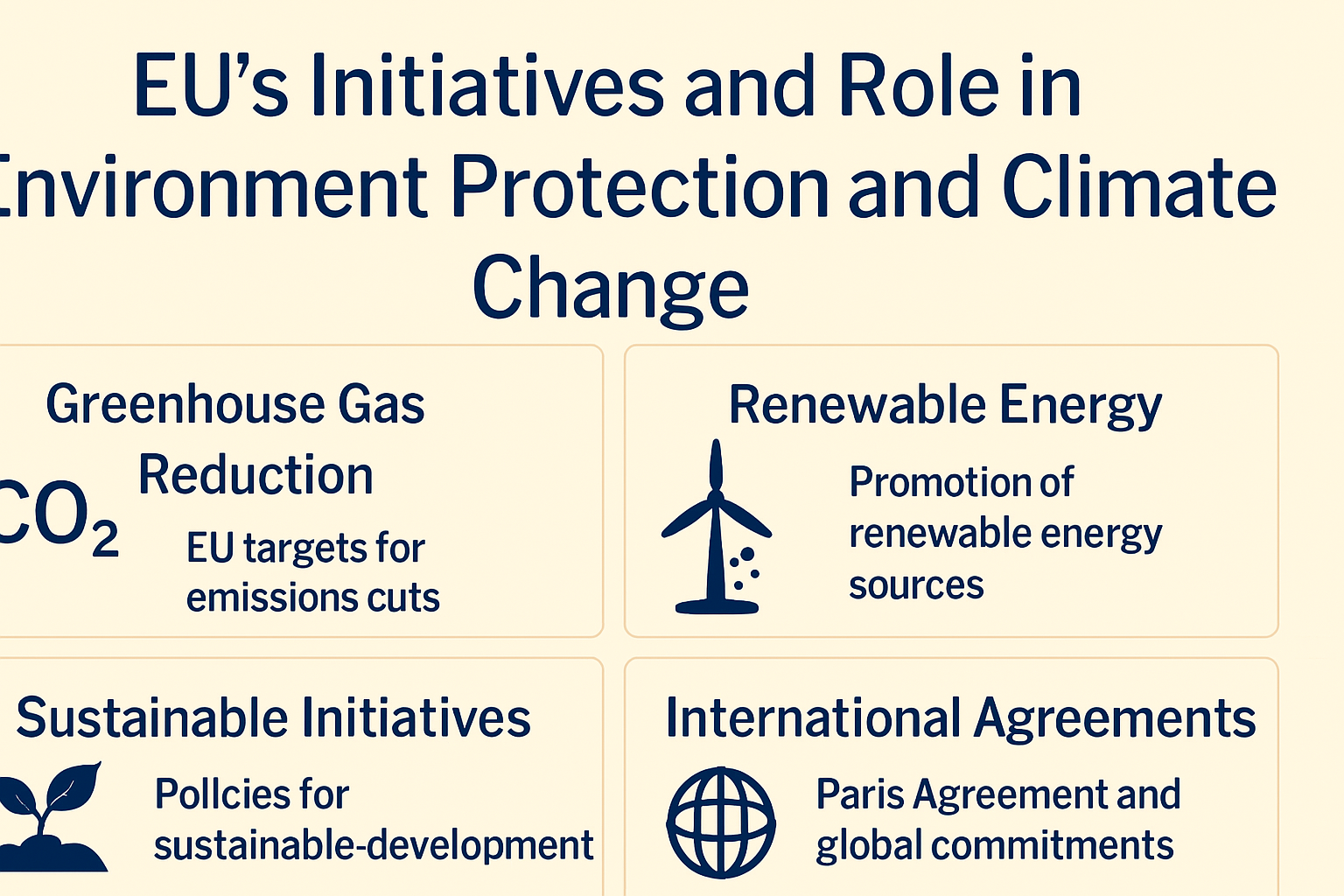


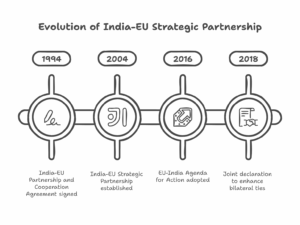
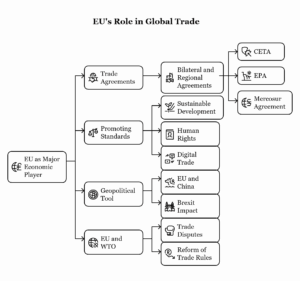
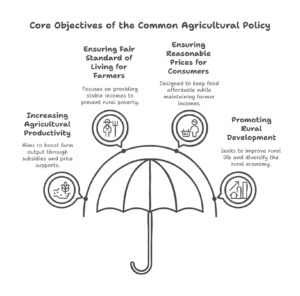
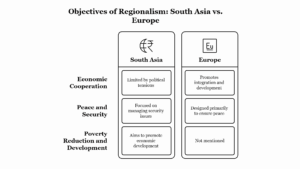

Leave a Reply